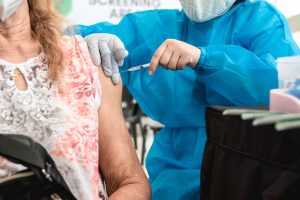Pneumonia is the leading cause of death caused by infectious diseases in the world and accounts for 15% of deaths of children under the age of five. Pneumonia is most prevalent in South Asia and infection can be caused by pathogens such as viruses, bacteria or fungi. Infants under the age of two and elderly above the age of 65 are most at risk.
What is pneumonia?
Pneumonia is an acute respiratory infection that occurs when the air sacs of the lungs become inflamed and swollen with pus and fluid, which makes breathing difficult and painful.
Types of pneumonia (by causative organism)
Bacterial
Streptococcus pneumonia is the most common bacterial pneumonia in children, followed by Haemophilus influenzae Type B. Transmission is via the inhalation of respiratory droplets such as coughing and sneezing, from an infected person. Streptococcus pneumonia is also the most common cause of community-acquired pneumonia, an important cause of bacterial meningitis, and swelling that occurs in the bone (osteomyelitis), amongst other infections.
Viral
Respiratory syncytial virus is the most common cause of pneumonia and inflammation of small airways in the lungs (bronchiolitis) in infants. This can occur when the virus spreads to the lower respiratory tract.
Fungal
Pneumocystis pneumonia is a serious form of pneumonia caused by the fungus Pneumocystis jirovecii. It is the most common cause in 25 percent of all pneumonia deaths in HIV-infected infants. Transmission of this fungus is through the air. Healthy adults can carry the fungus in their lungs and spread it to those who have weakened immunity. It commonly presents as an opportunistic infection in immunocompromised individuals, especially in patients with HIV who have low counts of white blood cells (CD4 + T cells).
Types of pneumonia (by how it is contracted)
Infections of hospital origin (hospital-acquired pneumonia) tend to involve drug-resistant pathogens as compared to those that arise from the community (community-acquire pneumonia). Aspiration pneumonia occurs when food or drinks are inhaled into the lungs due to swallowing impairment/ brain injury/ excessive sedation from the use of medications, alcohol, or other drugs.
Risk of complications
In a healthy person, there is a good balance between the organisms living in the respiratory tract and the immune defence mechanisms of the lungs. A higher chance of pneumonia occurs when this balance is offset in these cases:
- Compromised immune system due to ongoing diseases in patients who have cystic fibrosis, common variable immunodeficiency (CVID), cancer and HIV
- Reduced or impaired ability to clear mucous in cigarette smokers
- Impaired cough reflex in stroke or coma patients
- Inability to clear secretions due to bronchial obstruction
- Heart and kidney disease
- Malnourished infants, especially in those who are not exclusively breastfed
- Children are especially susceptible to pneumonia if their parents smoke or if they live in crowded air polluted environments
- Lung abscess that occurs when pus form in the lung cavities
- Fluid build-up in the lining between the lungs and chest cavity (pleural effusion)
Symptoms
Bacterial and viral pneumonia present with similar features but the symptoms of viral pneumonia are more severe and is usually accompanied by wheezing.
- Shortness of breath and rapid breathing
- High fever that lasts for a week if left untreated
- Cough with phlegm (sputum production)
- Chills
- Confusion in older patients who are severely ill
Treatment
Bacterial pneumonia
If pneumonia is caused by a bacterial infection, appropriate antibiotics based on the identified bacteria are prescribed. Mild cases of pneumonia tend to be treated with a short course of up to a week of oral antibiotics; commonly prescribed ones include amoxicillin, amoxicillin-clavulanate (Augmentin), clarithromycin, azithromycin, or levofloxacin.
Early treatment is crucial and in those who are severely ill, a difference of a few hours of treatment administration can impact clinical outcomes drastically. Broad spectrum antibiotic infusion treatments are given first while waiting for diagnostic microbial results in severe cases.
Viral pneumonia
In the case of viral infections, viral loads peak the highest two days after the onset of infection. Antiviral treatment such as neuraminidase inhibitors work the best if started within this window period.
Prevention
Infants are recommended to be vaccinated against the Haemophilus influenzae bacteria with Haemophilus influenzae (Hib) vaccine at two months of age. Vaccination with pneumococcal conjugate vaccines (PCVs) are known to induce robust immune responses and when given in childhood, can help with herd immunity and reduce incidence in the adult population.
Cessation of smoking and tobacco use are preventable lifestyle changes that can help to prevent pneumonia. Smoking damages the natural defences of the lungs against multiple respiratory infections as they decrease the muco-ciliary functions of the lungs to remove pathogens. Tobacco users are up to three times more likely to develop community-acquired pneumonia as compared to those who have never smoked in their lives.
Cutting down on alcohol is another preventative measure as alcohol has been shown to increase the risk of pneumonia of up to 80 percent in heavy drinkers.
Conclusion
Pneumonia can be fatal in up to 30 percent of severe cases and life-threatening complications may arise if medical attention is not sought. Environmental factors also play an important role in the transmission of the disease.
Article written in conjunction with World Pneumonia Day, which falls on 12 Nov 2021.











